Advertisements
Advertisements
प्रश्न
A body of mass m is attached to one end of a massless spring which is suspended vertically from a fixed point. The mass is held in hand so that the spring is neither stretched nor compressed. Suddenly the support of the hand is removed. The lowest position attained by the mass during oscillation is 4 cm below the point, where it was held in hand.
What is the amplitude of oscillation?
उत्तर
When the support of the hand is removed, the body oscillates about a mean position.
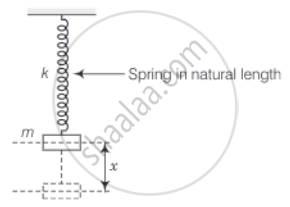
Suppose x is the maximum extension in the spring when it reaches the lowest point in oscillation.
Loss in PE of the block = `mgx` ......(i)
Where m = mass of the block
The gain in elastic potential energy of the spring = `1/2 kx^2` ......(ii)
As the two are equal, conserving mechanical energy,
We get, `mgx = 1/2kx^2` or `x = (2mg)/k` ......(iii)
Now, the mean position of oscillation will be, when the block is balanced by the spring.
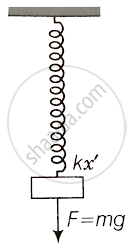
If x' is the extension in that case, then F = + kx'
But `F = mg`
⇒ `mg = + kx^'`
or `x^' = (mg)/k` ......(iv)
Dividing equation (iii) by equation (iv),
`x/x^' = ((2mg)/k)/((mg)/k)` = 2
⇒ `x = 2x^'`
But given x = 4 cm ......(maximum extension from the unstretched position)
∴ `2x^'` = 4
∴ `x^' = 4/2` = 2 cm
But the displacement of mass from the mean position to the position when the spring attains its natural length is equal to the amplitude of the oscillation.
∴ A = x' = 2 cm
Where A = amplitude of the motion.
APPEARS IN
संबंधित प्रश्न
The pendulum of a clock is replaced by a spring-mass system with the spring having spring constant 0.1 N/m. What mass should be attached to the spring?
A block of mass 0.5 kg hanging from a vertical spring executes simple harmonic motion of amplitude 0.1 m and time period 0.314 s. Find the maximum force exerted by the spring on the block.
The springs shown in the figure are all unstretched in the beginning when a man starts pulling the block. The man exerts a constant force F on the block. Find the amplitude and the frequency of the motion of the block.
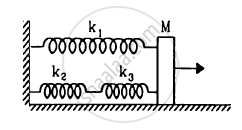
Consider the situation shown in figure . Show that if the blocks are displaced slightly in opposite direction and released, they will execute simple harmonic motion. Calculate the time period.
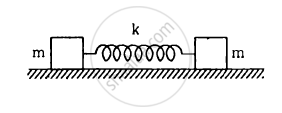
A 1 kg block is executing simple harmonic motion of amplitude 0.1 m on a smooth horizontal surface under the restoring force of a spring of spring constant 100 N/m. A block of mass 3 kg is gently placed on it at the instant it passes through the mean position. Assuming that the two blocks move together, find the frequency and the amplitude of the motion.
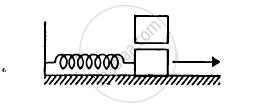
Find the elastic potential energy stored in each spring shown in figure when the block is in equilibrium. Also find the time period of vertical oscillation of the block.
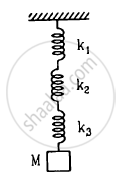
Motion of an oscillating liquid column in a U-tube is ______.
Displacement versus time curve for a particle executing S.H.M. is shown in figure. Identify the points marked at which (i) velocity of the oscillator is zero, (ii) speed of the oscillator is maximum.

A mass of 2 kg is attached to the spring of spring constant 50 Nm–1. The block is pulled to a distance of 5 cm from its equilibrium position at x = 0 on a horizontal frictionless surface from rest at t = 0. Write the expression for its displacement at anytime t.
The total energy of a particle, executing simple harmonic motion is ______.
where x is the displacement from the mean position, hence total energy is independent of x.
